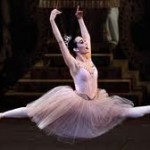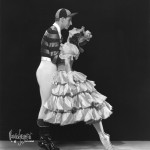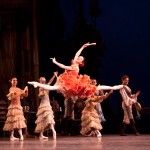Toba Singer reported from Santa Fe College in Gainesville, Florida, which presented Alberto Alonso’s Carmen Suite, staged by his widow, former Cuban National Ballet dancer, Sonia Calero, on Nov. 8 and 9, 2019.
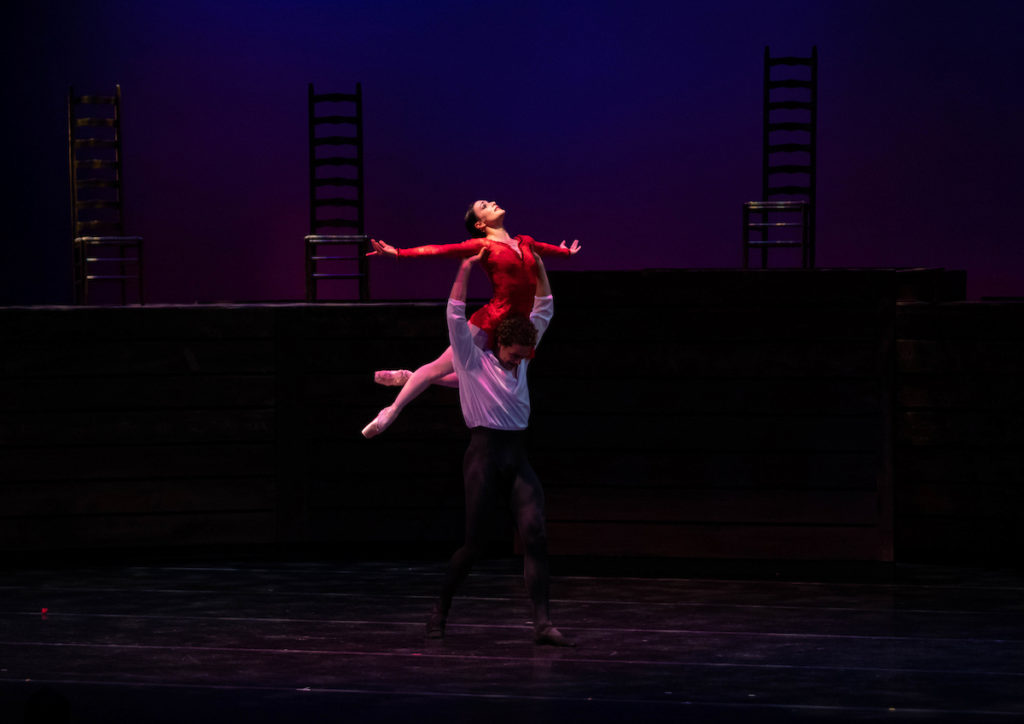
Sarah Lane and Cory Stearns of American Ballet Theatre in Alberto Alonso’s Carmen Suite performed at the Santa Fe College Fine Arts Hall on Nov. 9, 2019 in Gainesville, Fla. Staged by: Sonia Calero-Alonso. (Photo: Matt Stamey/Santa Fe College)
It was an homage to Alonso, who had taught at Santa Fe from 1994-2008, to mark the tenth anniversary of his death. The work was danced by American Ballet Theatre dancers Sarah Lane as Carmen, Cory Stearns as Don José, and Luis Ribagorda, Lane’s companion in private life, as Torrero/Escamillo. Davis Robertson, of New York Dance Project, danced the role of Zuñiga. Brittany Larrimer and Francesca Karszewski danced The Bull. Dance Project members performed corps de ballet roles.
On Nov. 7, Toba Singer, Artist in Residence and author of “Fernando Alonso, the Father of Cuban Ballet,” engaged Calero, Lane, Stearns, Ribagorda, and Alora Haynes, Chair of Santa Fe’s Department of Fine and Performing Arts, in the following roundtable discussion. What follows is a transcript, edited for clarity and length. (Note: Calero spoke in Spanish; Ribagorda provided interpretation, with assistance from Singer.)
Toba Singer: What inspired bringing Alberto Alonso’s “Carmen Suite” to Santa Fe College at this time?
Alora Haynes: I met Alberto Alonso, whose son came to Miami by raft in 2003, while Alberto and Sonia were in Mexico, where they learned of their son’s defection. Sonia and Alberto tried to immigrate to Mexico, but weren’t accepted by the Mexican government. Wanting to be near their son once they located him, mutual acquaintances brought Alberto and Sonia to our house, where they made their home for a while, and were very much part of our family. Then Alberto came to work here, both of them eventually teaching and living here for 15 and 18 years, respectively. His greatest concern was that he might die without recognition for all that he accomplished. So we decided to dedicate this staging by Sonia of “Carmen Suite” to what he gave his life to, both in Cuba and here in Gainesville at Santa Fe College.
TS: At first glance, “Carmen” appears to be a fiery work, filled with sweeping dramatic gestures, jutted hips, planted feet, and virtuosic displays, but aren’t there also important subtleties, where the devil is truly in the details of the characters’ portrayals. Would you say something about that?
Sonia Calero: She’s a gypsy. Alberto was inspired by the book, and developed his concept of Carmen in order to adapt it to ballet. She’s a free woman. No one can control her. Many years ago, gypsies had a reputation for not being trustworthy, but the truth of the matter is that they simply didn’t go by society’s rules. In her case, she’s flirtatious but not a prostitute. She falls in love, then out of love, and then falls for another. Don José is a very shy soldier, but can’t take his eyes off of her. She’s not interested, sees him as a common solder, timid. But he’s the captain and under the domination of the dictator Zuñiga. Zuñiga controls everyone, but he can’t control Carmen; wants to, but can’t. She fights other women in town. They are jealous of her independence. José is going to arrest her and that’s when she begins flirting with him to avoid jail. She inveigles him into letting her go. He doesn’t know what he’s in for. She uses her feet planted [plantados], hips jutted [sobresalientes], and the overall style, insouciant [despreocupado], to assert her independence. When Alberto made Carmen on Maya Plisetskaya in the Soviet Union, it was a work that broke all the rules of socialist realism, and so it was banned, but Maya spoke with the Minister of Culture, and said, “You can kill me, but you’ll never kill Carmen. When she turned 80, Maya held a press conference to say “Even if I die, Carmen will live on . . .”
Sarah Lane: I find it liberating to dance the role because women have always been put in a box by the Zuñigas of the ballet world, especially when it comes to sexuality. I value the ability of an artist like Maya Plisetskaya to draw on and express her natural sexuality in depth. This is in part a function of her fearlessness. Fear can become a script based on other people’s rules and opinions that you shouldn’t have to live by. We can see that so clearly in how people tend to project who they are because of social media. It makes it so easy to put out a fake version of yourself, a façade, the very thing Carmen rejects with a literal sweep of the hand when it is offered to her as a way to save herself from Zuñiga’s retribution. She prefers to be herself and stand up for who she is, even though it costs her her life.

Sarah Lane and Luis Ribagorda of American Ballet Theatre in Alberto Alonso’s Carmen Suite; performed at the Santa Fe College Fine Arts Hall on Nov. 9, 2019 in Gainesville, Fla. Staged by: Sonia Calero-Alonso. (Photo: Matt Stamey/Santa Fe College)
TS: Does each of you have at least one Carmen in your life? If so, describe her please, and what in her personality corresponds to the character in Alberto Alonso’s ballet?
Luis Ribagorda: My mother is Carmen! She’s a Madrileña who appreciates life and lives it affirmatively. To probe the characters we dance, dancers should really take acting lessons. I’ve taken them, and they open up a path to a broader scope of character development. It is never sufficient to just do the steps, but especially in a ballet like this one. There are dancers who just do them, but fail to grasp the feelings they are meant to probe. It not only feels good to find your own interpretation from within, it’s a very important tool as you work for the style and technique. It should be your first priority to become adamant about the whole process of developing a character. There must always be an intention in every beat. Perfecting the steps can come later. I’m very happy with this trio. I think I have a good grasp of what they’ll do with their roles, and so I know how mine relates to theirs.
Cory Stearns: Yes, there are certainly those in my life whose personalities have elements of Carmen, who is fickle or Don José, who is not as fickle. I’d say that in the dance world, a lot of dancers tend to be more sensual and self-aware because we work and communicate with our bodies and it’s beneficial to have that freedom that Carmen leads with, a feminist, or liberated attitude towards sexuality. A dancer who knows who she is and is fearless onstage, shows up with more charisma. When I was younger, I was very much like Don José, the role I dance, in exactly how he has such limited experience as a male in society, inculcated from birth with chauvinistic views. He’s in the military and there are no women, and he’s star struck by Carmen. I had crushes on girls who were my dance partners. I couldn’t think of things to say, and would freeze up in their presence. Everything they stood for was so affecting. He’s not as visible in his personality as Carmen is. As a male dancer we are more developed, encouraged to stand out, so you would not find among us the kind of character that we see in Don José. The kind of society he lives in has cultivated restraint in him, and so for a dancer, it’s hard to identify with him, and it can be tough to limit how you express yourself by holding back. You almost have to change what comes naturally to you to capture what comes unnaturally to him.
SL: I can relate, because I’m shyer and not as self-assured as Carmen, so I have to bring that out in myself, so that I can be fiery and emotional. Luis’ mom is someone I look to as a means of finding Carmen. She is strong, opinionated, impassioned and saucy. She goes with her feelings and convictions. She loves, and loves passionately, though because she’s gone through so much, she tends to be free of judgment regarding her or others. Above all, she sees the beauty in life. There’s a lack of inhibition in the way that she enjoys it.
CS: Yes, to live confidently, unaffected by taboo: that’s Carmen!
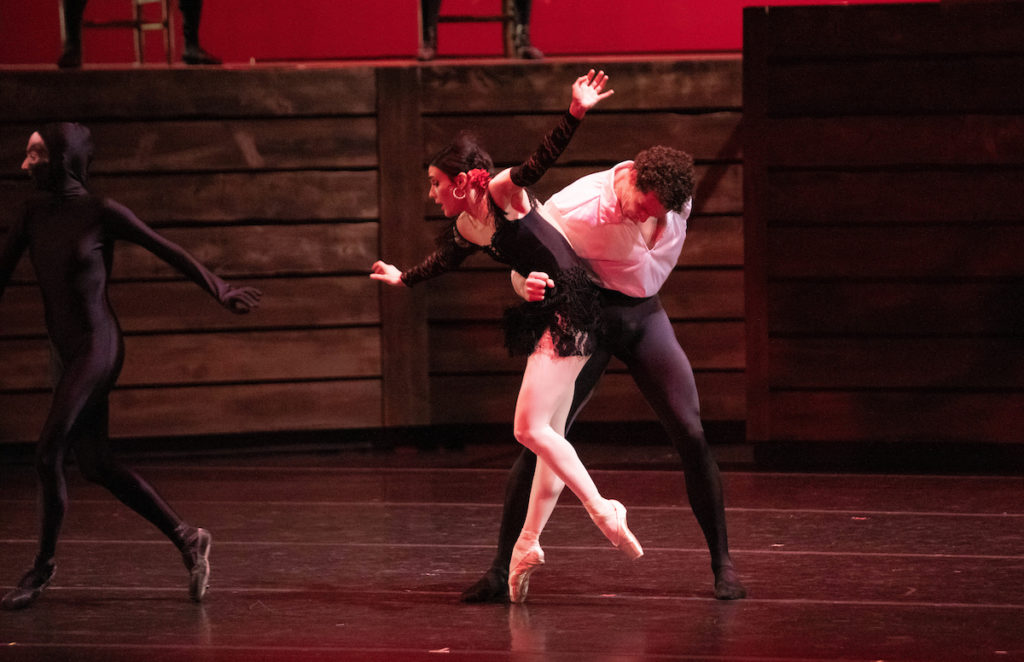
Sarah Lane and Cory Stearns of American Ballet Theatre in Alberto Alonso’s Carmen Suite performed at the Santa Fe College Fine Arts Hall on Nov. 9, 2019 in Gainesville, Fla. Staged by: Sonia Calero-Alonso. (Photo: Matt Stamey/Santa Fe College)
TS: Whom do you admire most in the Carmen role?
SL: The most authentic is Alicia Alonso. She had the spirit to survive and do what she wanted no matter what, including blindness!
SC: In this version of “Carmen” there are different styles, and not all classical dancers can do it, because of varying physicality. If they are intelligent, a bit cagey, and know how to manipulate people and mold them, and still end up with those people liking them, it is much easier to turn them into Carmen! [Laughter]
CS: And you never know when it comes to casting. You can think: “She would be perfect for the role, but it’s not good to go for a stereotype, because oftentimes you are wrong, or the dancer plays to the stereotype with poor results. When I was younger, I saw people I could have sworn would fit a role, and then they didn’t, and there were those I’d never have chosen to dance it, but did, and they were perfect for it.
TS: What is the significance for each of you of Alberto having placed certain characters on a tier overlooking the stage?
SC: It’s an arena, and above it there sits the dictator with his henchmen who are two-faced (each face is divided down the middle, using makeup.) Along with him, they are always watching what takes place in the arena among those below. It’s the setting for an inquisition.
TS: In a 1967 interview conducted by Pedro Simón published in the Cuban magazine Cuba en ballet, Alberto Alonso says that he imagined that there was something of Carmen in The Bull [El Toro]. How does that comment strike you? How do your characters see themselves in the triangles that form between Carmen, The Bull, and the male characters, Don José, Escamillo, and Zuñiga?
SC: The Bull is Fate, whose destiny plays out in the arena. The death of the bull is also the death of Carmen because she goes to the fiesta in the plaza and Don José goes to find her there, and when she decides that she doesn’t want to be there anymore, he becomes jealous and intends to act on that and carry out Zuñiga’s orders, but she negotiates her freedom using flirtatiousness, and there’s temporary stay, and they both go free. But in the end, her refusal to cooperate with Don José’s protocols ends up being her undoing. Her plaything, the bullfighter Escamillo, kills the bull and Don José kills Carmen.
TS: What stands out as unique in the experience of working with Sonia that you will carry with you into future roles or projects?
SL: My soul (The Bull)!
TS: Frank Boehm’s documentary “Alicia,” closes with a statement by Alicia Alonso that “even if there is only one person who leaves the theater” inspired and changed by what they have seen, “no amount of money, nothing that you can earn in your lifetime,” can compare with the feeling of what Alonso calls “the life of an artist.” What do you hope members of your audience here in Gainesville will recall every time they hear the opening bars of the Rodion Shchedrin / Bizet score?
SL: This is a work that embodies far more than just characters. It carries huge metaphorical significance of the kind that is necessary for art to survive, or it turns from art into something like the gymnastics you see in competitions. Relevance is what you want to bring to an audience. That’s what people are looking for who come to the ballet. They come to see a work that goes deeper than just the turns and jumps that we refer to as “tricks.” You can find acting and interpretation in film and on TV, but in ballet, the audience looks to the body to tell the story, and the dancer in that body has to arrive with intentions in place.
AH: I hope that they will absorb the backstory. I’m so drawn to the educational value. I feel a huge responsibility to bring that to my students here at Santa Fe, to see the power of art to bring a dissonant message.
CS: I see it as a cultural battle between a portion of society that believes that the arts take money away from the economy, and amount to a feeble excuse for artists to feel self-important, and those who see the arts as a medium for making them feel emotionally, having certain opportunities to see and experience something that affects them, which then allows them to recognize the importance of art in society. Perspectives on both sides are in a public battle in order to remain relevant. It’s not a question of those of us who are artists going begging to save [our] own jobs. In my case, I have experienced being moved in the theater from a young age, and so I pursued a profession that is by no means lucrative, because I recognize its importance, and the absolute need for it to move forward to educate audiences and get the public into theaters.
More: watch a panel discussion on Nov. 8 which featured Singer, Calero, and Robert De Warren, formerly of London’s Royal Ballet and former Artistic Director of Sarasota Ballet:

